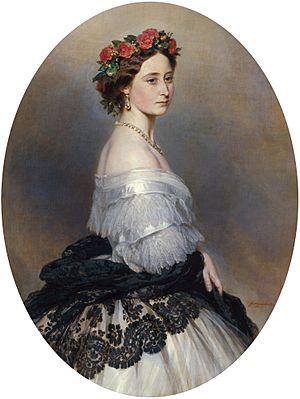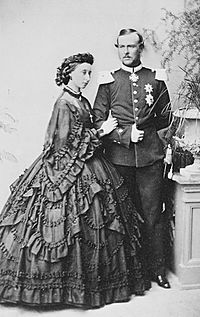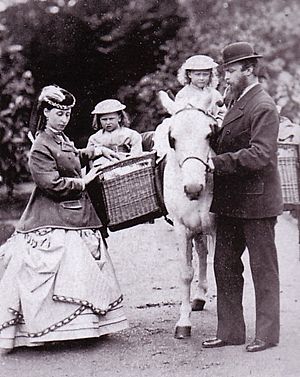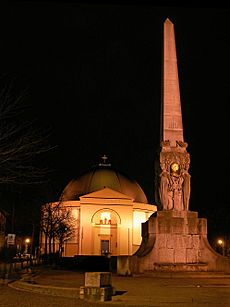Princess Alice of the United Kingdom facts for kids
Quick facts for kids Alice |
|||||
|---|---|---|---|---|---|
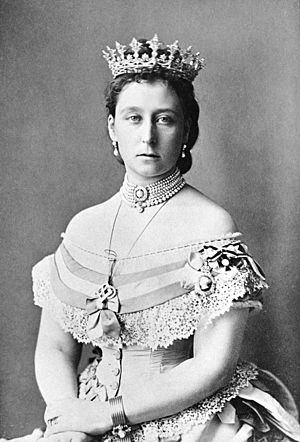
Photograph by Franz Backofen, 1871
|
|||||
| Grand Duchess consort of Hesse and by Rhine | |||||
| Tenure | 13 June 1877 – 14 December 1878 | ||||
| Born | 25 April 1843 Buckingham Palace, London, England |
||||
| Died | 14 December 1878 (aged 35) New Palace, Darmstadt, Grand Duchy of Hesse, German Empire |
||||
| Burial | 18 December 1878 Neues Mausoleum, Rosenhöhe Park, Darmstadt, Grand Duchy of Hesse, German Empire |
||||
| Spouse |
Louis IV, Grand Duke of Hesse and by Rhine
(m. 1862) |
||||
| Issue |
|
||||
|
|||||
| House | Saxe-Coburg and Gotha | ||||
| Father | Prince Albert of Saxe-Coburg and Gotha | ||||
| Mother | Queen Victoria of the United Kingdom | ||||
Princess Alice (born Alice Maud Mary; 25 April 1843 – 14 December 1878) was a daughter of Queen Victoria of the United Kingdom. She later became the Grand Duchess of Hesse and by Rhine when she married Louis IV, Grand Duke of Hesse and by Rhine. Alice was the third child and second daughter of Queen Victoria and Prince Albert.
Her life was marked by sadness, especially after her father's death in 1861. Alice was the first of Queen Victoria's nine children to pass away. She was also one of three children who died before their mother.
Alice was known for her kindness and her interest in helping others. She was especially interested in nursing, inspired by Florence Nightingale. She worked to improve hospitals and train nurses. Her life in Darmstadt, Germany, was often difficult due to money problems and family tragedies. In 1878, she died from diphtheria after caring for her sick family.
Contents
Early Life and Education
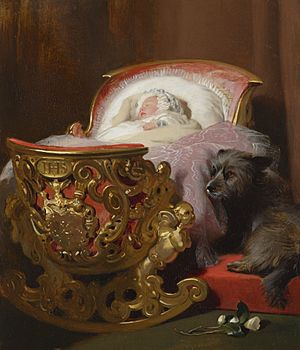
Alice was born on 25 April 1843 at Buckingham Palace in London. She was christened "Alice Maud Mary" in the palace's private chapel. Her parents, Queen Victoria and Prince Albert, wanted a larger family home. So, in 1844, they bought Osborne House on the Isle of Wight for family holidays.
Alice's education was planned by her father and his friend, Baron Stockmar. She and her siblings learned practical skills like cooking, gardening, and carpentry. They also had daily lessons in English, French, and German.
The royal family believed in strong family values. Alice and her siblings wore simple clothes and slept in plain bedrooms. Alice was curious about the world outside the royal court. She enjoyed visiting people who lived and worked on the Balmoral estate. Once, she even sat in a public pew at Windsor Castle to see how ordinary people worshipped.
In 1854, during the Crimean War, eleven-year-old Alice visited London hospitals. She saw wounded soldiers with her mother and older sister. Alice was very sensitive and cared deeply about other people's problems. She was close to her brother, the Prince of Wales, and her eldest sister, The Princess Royal.
A Caring Daughter and Sister
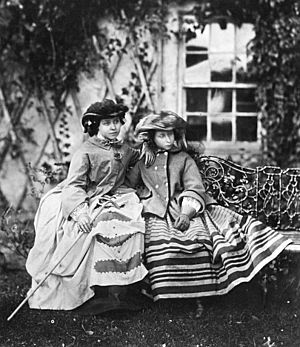
Alice became the family caregiver in 1861. Her grandmother, the Duchess of Kent, became very ill. Alice spent a lot of time by her grandmother's side, playing the piano and nursing her. After her grandmother died, Queen Victoria was overcome with grief. Alice comforted her mother, as Prince Albert had asked her to.
A few months later, on 14 December 1861, Prince Albert died at Windsor Castle. Alice stayed by his side during his final illness. She even sent for her brother, the Prince of Wales, without her mother's knowledge. Queen Victoria was devastated by her husband's death. The royal court went into a long period of mourning.
Alice became her mother's unofficial secretary for six months. She handled official papers between the Queen and her government. This was because the Queen stayed away from public life. Alice was helped by her younger sister, Princess Louise.
Marriage and New Life
Finding a Husband
Queen Victoria started looking for a husband for Alice in 1860. The Queen wanted her children to marry for love. However, they still had to marry into other royal families in Europe. This was important for making useful alliances with other countries.
Alice's sister, Princess Victoria, helped look for suitable princes. Two main candidates were found: the Prince of Orange and Prince Albert of Prussia. But Alice did not like the Prince of Orange. Prince Albert was also not considered good enough.
Then, Princess Victoria suggested Prince Louis of Hesse. He was a minor German royal. Louis and his brother were invited to Windsor Castle in 1860. This was a chance for Queen Victoria to meet her potential son-in-law. The Queen liked Louis and noticed how well he and Alice got along. Louis asked for Alice's photograph, and Alice showed she was interested in him.
Engagement and Wedding Day
Alice and Prince Louis of Hesse became engaged on 30 April 1861. Queen Victoria got Parliament to agree to give Alice a dowry of £30,000. This was a large sum at the time. However, Prince Albert noted it would not be "great things" in the small country of Hesse.
Before the wedding, Alice's father, Prince Albert, died on 14 December 1861. Despite the Queen's deep sadness, she ordered the wedding to go ahead. On 1 July 1862, Alice and Louis were married privately. The ceremony took place in the dining room of Osborne House, which was turned into a temporary chapel.
The Queen was brought in by her four sons, who shielded her from view. She sat in an armchair near the altar. Alice was given away by her uncle, Ernest II, Duke of Saxe-Coburg and Gotha. Her younger sisters were her bridesmaids. Alice wore a simple white dress with a lace veil. However, she had to wear black mourning clothes before and after the ceremony.
The Queen cried during the service. The weather was gloomy. The Queen later wrote that the ceremony felt "more of a funeral than a wedding." It was described as "the saddest royal wedding in modern times." After the ceremony, the couple went on their honeymoon.
Life in Darmstadt
Alice and Louis arrived in Darmstadt, Hesse, on 12 July 1862. Cheering crowds greeted them. Alice wrote to her mother that the people gave them a "hearty welcome."
Alice found it hard to adjust to her new home at first. She missed England and her father. The Grand Duke was not willing to spend a lot of money on a grand home for Alice. So, they were given a house in Darmstadt's "Old Quarter." It was a simple house, but Alice liked it. She spent time learning about her new surroundings.
In 1863, Alice returned to England for her brother's wedding. She gave birth to her first child, Victoria, on 5 April. Alice's relationship with her mother became difficult. When Alice returned to Darmstadt, she and Louis received a new home, Kranichstein. Alice had her second daughter, Elisabeth, in 1864. Alice chose to breastfeed her baby, which upset her mother.
The Austro-Prussian War
In 1866, a war broke out between Austria and Prussia. Hesse sided with Austria. This meant Alice and her sister Victoria, who was married to the Prussian Crown Prince, were technically on opposing sides.
Alice was pregnant with her third child. She saw Louis leave to command the Hessian cavalry. She sent her children to stay with Queen Victoria in England. Despite being pregnant, Alice took on royal duties. She made bandages for soldiers and prepared hospitals. On 11 July, she gave birth to Princess Irene.
As Prussian troops neared Darmstadt, Alice urged the Grand Duke to surrender. She knew that the German states would likely form a union, which she supported. Alice and Louis wrote many letters during the war. Alice worried about Louis, and he told her not to worry.
Panic spread in Darmstadt, but an armistice was eventually made. Louis returned, and he and Alice visited the wounded together. Alice spent much time helping the sick and injured. She was friends with Florence Nightingale, who sent money and advice on hospital cleanliness.
Alice was upset by how Prussian troops behaved in Hesse. They took over railways and telegraph systems and demanded money. Alice wrote to her mother about the "painful and distressing position" she was in. However, the Emperor of Russia and Alice's sister Victoria helped convince the Prussian King to let the Grand Duke keep his throne.
Later Life and Challenges
In 1873, a great tragedy struck Alice. Her youngest son, Friedrich, nicknamed "Frittie," died after falling from a window. Frittie had haemophilia, a condition where blood does not clot properly. He suffered internal bleeding and died. Alice was heartbroken and never fully recovered.
After Frittie's death, Alice became very close to her only surviving son, Ernest, and her newborn daughter Marie. In 1875, she returned to her public duties. These included fundraising and social work, especially in medicine. She kept in touch with social reformer Octavia Hill.
However, her relationship with her husband became difficult. In late 1876, she went to England for a health issue. She wrote to Louis, criticizing his letters for being childish. The next day, she wrote a kinder letter, hoping her previous one had not upset him.
On 20 March 1877, Louis's father died, making Louis the heir. On 13 June, Louis's uncle, Grand Duke Louis III, died. Louis and Alice then became the Grand Duke and Duchess of Hesse. Alice was still not very popular in Darmstadt. She found her new duties overwhelming. She tried to improve social conditions in Darmstadt, but it was very tiring.
Alice was upset by rumors and a harsh letter from Queen Victoria. She complained to Louis, saying the letter "made me cry with anger." Despite these challenges, Alice continued her work. She enjoyed Christmas 1877 when her family gathered. In autumn 1878, Queen Victoria paid for the family to holiday in England. Alice performed royal duties and visited her mother before returning to Darmstadt.
Final Illness and Death
In November 1878, diphtheria spread through the Grand Ducal household. Alice's eldest daughter, Victoria, was the first to get sick. Soon, her children Alix, Marie, Irene, and Ernest also became ill. Her husband Louis also got sick. Only Elisabeth was spared, as Alice sent her away.
Marie became very ill on 15 November. Alice rushed to her side, but Marie died shortly after. Alice was devastated. She kept Marie's death a secret from her other children for weeks. When she finally told Ernest, he cried. Alice hugged and kissed him, breaking her rule about not touching the sick.
Alice did not get sick at first. She met her sister Victoria and wrote to her mother, sounding more cheerful. However, on Saturday, 14 December, the anniversary of her father's death, Alice became seriously ill with diphtheria. Her last words were "dear Papa." She died just after 8:30 am.
Alice was buried on 18 December 1878 at the Grand Ducal mausoleum in Rosenhöhe, outside Darmstadt. The Union Flag was placed over her coffin. A special monument for Alice and her daughter Marie was built there.
Alice was the first of Queen Victoria's children to die. Her mother outlived her by more than 20 years. Queen Victoria noted the strange coincidence of Alice and Albert dying on the same date. She wrote in her journal about the family's recent suffering. Queen Victoria praised Alice, saying she had her father's kind and devoted nature.
Alice's death was deeply felt in Britain and Hesse. Newspapers wrote about her kindness and dedication to her family and duty. The royal family was also very sad. Alice's brother, the Prince of Wales, wrote that she was his "favourite sister."
Legacy and Impact
Alice founded the Alice-Hospital in Darmstadt in 1869. It was built to treat the sick and wounded in the city. This organization continued to thrive long after Alice's death. In 1953, her grandson, Louis, Earl Mountbatten of Burma, spoke highly of Alice's work. He said she always focused on helping sick people and their needs.
Alice also started other organizations. These included the Alice Society for Women's Training and Industry, which aimed to educate women. She also created the Princess Alice Women's Guild, which trained nurses. These groups were very important during the Austro-Prussian War.
There are memorials to Alice in Darmstadt, Germany; Whippingham, Isle of Wight; and in the Frogmore Royal Mausoleum at Windsor.
Alice's Descendants
Alice's children and grandchildren played important roles in history.
- Her fourth daughter, Alix, married Tsar Nicholas II of Russia. Alix passed on her mother's gene for haemophilia to her only son, Tsarevich Alexei. Alix, her husband, and their children were killed by the Bolsheviks in 1918.
- Alice's second daughter, Elizabeth, married Grand Duke Sergei Alexandrovich of Russia. She also was killed by the Bolsheviks in 1918.
- Louis Mountbatten, the son of Alice's eldest daughter Victoria, became the last Viceroy of India. He was assassinated in 1979.
- Prince Philip of Greece and Denmark, Alice's great-grandson, married Elizabeth II of the United Kingdom.
Honours
- 1 January 1878: Companion of the Order of the Crown of India
 26 June 1871: Cross of Merit for Women and Girls
26 June 1871: Cross of Merit for Women and Girls Dame of the Order of Louise, 1st Division
Dame of the Order of Louise, 1st Division 1864: Grand Cross of the Imperial Order of Saint Catherine
1864: Grand Cross of the Imperial Order of Saint Catherine
Issue
| Name | Birth | Death | Notes | Ref(s). |
|---|---|---|---|---|
| Victoria Alberta Elisabeth Mathilde Marie | 5 April 1863 | 24 September 1950 | Married Prince Louis of Battenberg; had 2 sons and 2 daughters, including Queen Louise of Sweden. | |
| Elisabeth Alexandra Luise Alix | 1 November 1864 | 18 July 1918 † | Became Elizabeth Feodorovna after joining the Russian Orthodox Church. Married Grand Duke Sergei Alexandrovich of Russia; had no children. | |
| Irene Louise Marie Anne | 11 July 1866 | 11 November 1953 | Married her cousin Prince Henry of Prussia; had 3 sons. Two of her sons had haemophilia. | |
| Ernest Louis Charles Albert William | 25 November 1868 | 9 October 1937 | Became Grand Duke of Hesse and by Rhine in 1892. Married (1) Princess Victoria Melita of Saxe-Coburg and Gotha; had 1 daughter. Married (2) Princess Eleonore of Solms-Hohensolms-Lich; had 2 sons. | |
| Friedrich William Augustus Victor Leopold Louis | 7 October 1870 | 29 May 1873 | Had haemophilia and died from internal bleeding after a fall at age two. | |
| Alix Viktoria Helene Luise Beatrix | 6 June 1872 | 17 July 1918 † | Became Alexandra Feodorovna after joining the Russian Orthodox Church. Married Tsar Nicholas II of Russia; had 1 son and 4 daughters. Her son, Tsarevich Alexei, had haemophilia. | |
| Marie Victoria Feodore Leopoldine | 24 May 1874 | 16 November 1878 | Died from diphtheria at age four. | |
| † murdered by Bolshevik revolutionaries | ||||
See also
 In Spanish: Alicia del Reino Unido para niños
In Spanish: Alicia del Reino Unido para niños



